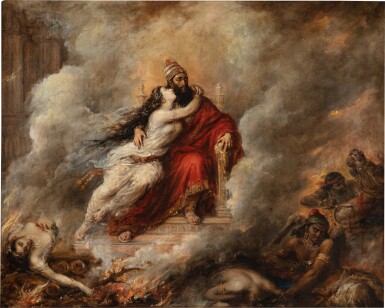Tableaux, Dessins, Sculptures 1300-1900
Tableaux, Dessins, Sculptures 1300-1900

Alexandre-Marie Colin
The Death of Sardanapalus | La Mort de Sardanapale
Lot Closed
November 10, 03:58 PM GMT
Estimate
20,000 - 30,000 EUR
Lot Details
Description
Alexandre-Marie Colin
Paris 1798-1873
The Death of Sardanapalus
Oil on canvas
65 x 80,5 cm ; 25⅝ by 31¾ in.
___________________________________________
Alexandre-Marie Colin
Paris 1798-1873
La Mort de Sardanapale
Huile sur toile
65 x 80,5 cm ; 25⅝ by 31¾ in.
Born in the same year as Eugène Delacroix (1798-1863), Colin entered the School of Fine Arts in 1814; there, both he and Delacroix attracted the attention of their teachers by winning the drawing and composition prizes. Colin was also enrolled in the studio of Girodet (1767-1824). Early in his career, he was in the avant-garde of Romanticism and received much the same criticism as Delacroix for his choice of subjects, while being praised for his talent as a painter. Although his refined style gave him a reputation as an accomplished portraitist, it was particularly well suited to historical and literary subjects on the scale of easel paintings, which he pioneered together with his close friend Bonington. Colin never achieved the fame of Bonington or Delacroix but assiduously presented his works to the Salon between 1819 and 1868. As Delacroix had also done, he depicts Sardanapalus, but in a mise-en-scène closer to Lord Byron’s account. This painting seems to be the one that was sold in the sale of his assets, after his death, on 2 February 1876.
Colin, an early admirer of Lord Byron, very early on drew his inspiration from the work of the British author, he perhaps produced this painting before the famous painting by Delacroix on the same subject. In a typically Romantic setting, Colin shows the Emperor of Assyria on his throne upon the burning pyre, accompanied by his favourite concubine Myrrha, solemnly and nobly awaiting the death that he has chosen for himself.
___________________________________________
Né la même année qu'Eugène Delacroix (1798-1863), Colin entre à l'école des Beaux-Arts en 1814, où lui et Delacroix attirent l'attention de leurs professeurs en remportant des prix de dessin et de composition. Colin est également inscrit dans l'atelier de Girodet (1767-1824)iç. Au début de sa carrière, il était à l'avant-garde du romantisme et faisait l'objet de critiques similaires à celles que recevait Delacroix pour le choix de ses sujets, tout en étant loué pour ses talents de peintre. Son style raffiné lui permet de jouir d'une réputation de portraitiste accompli mais s’adapte surtout particulièrement bien aux sujets historiques et littéraires dans des formats de tableau de chevalet dans lesquels lui et son ami proche Bonington étaient des pionniers. Colin n'a jamais atteint la renommée de Bonington ou de Delacroix mais a présenté assidûment ses œuvres au Salon entre 1819 à 1868. À l’instar de Delacroix mais dans une mise en scène plus fidèle à Lord Byron, il réalise ce Sardanapale qui semble être celui vendu lors de sa vente après décès du 2 février 1876. Colin admirateur de la première heure de Lord Byron a puisé très tôt son inspiration dans l’œuvre de l’auteur britannique, il a peut-être réalisé ce tableau avant le célèbre tableau de Delacroix du même sujet. Colin représente l’empereur d’Assyrie, dans une mise en scène typiquement romantique, assis sur son trône, accompagné de sa favorite Myrrha, au-dessus du bûcher en flamme, attendant la mort qu’il s’est choisie avec gravité et noblesse.
